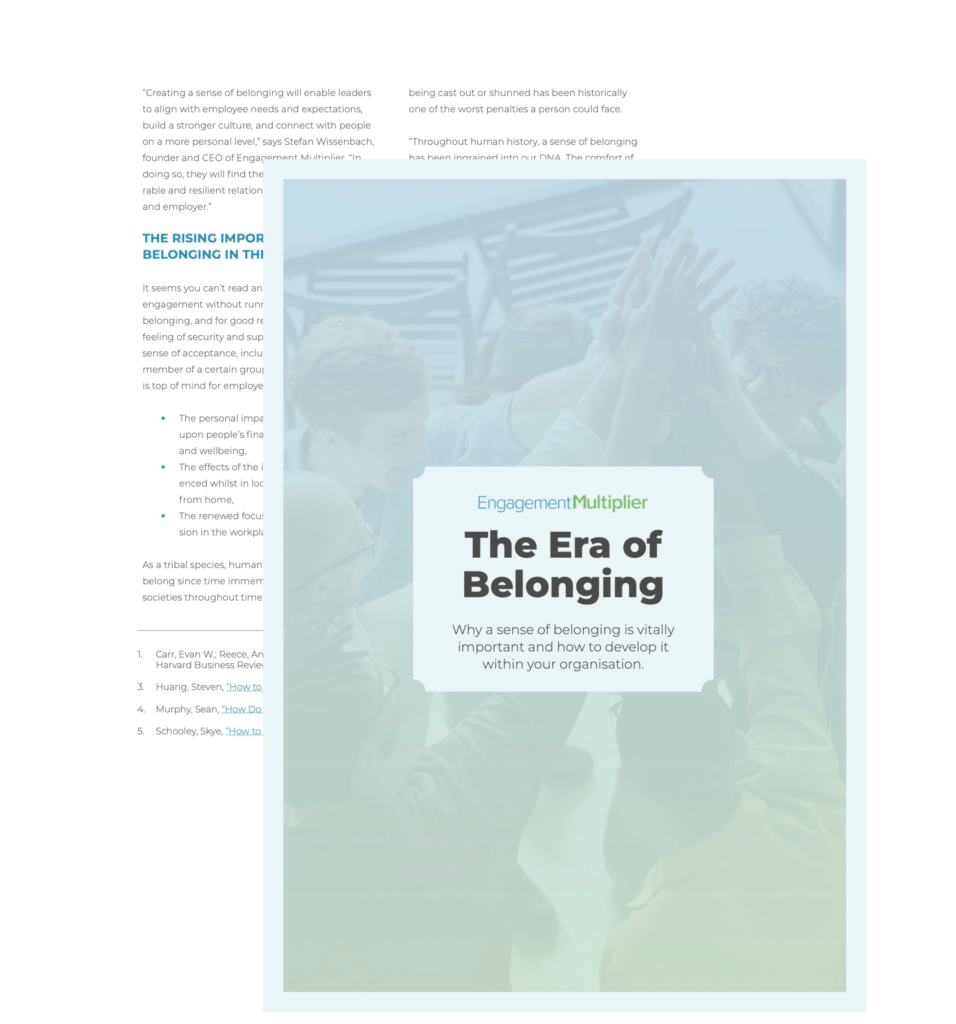Today we’re releasing our new white paper, “The Era of Belonging,” and, I believe, it’s our most important and impactful yet.
Here’s why.
Leading up to the pandemic, many organisations had it reasonably easy for quite some time. Their businesses functioned quite well. Their high-quality leadership teams were talented leaders of people, and had a good understanding of their businesses.
Then Covid-19 came along and turned things upside down.
As we emerge into the new normal, leaders are realising the outsize impact the pandemic has had on their people. Some are in “languishing” mode, going through the motions but lacking their former spark. Others are still dealing with the fallout of lockdown restrictions and homeschooling. A disproportionate number of women are electing to leave the workforce. A fair number of people are taking this moment to reassess their lives, and change careers.
These factors are the reasons why multiple surveys conducted this year suggest that more than half of employees are either looking for a new job or planning to do so in near future.
Half.
No one wants to lose their top talent, especially at a moment like this, when key players are vitally necessary for business recovery.
And, certainly, few businesses could succeed unimpeded if double-digit percentages of their employees ran for the exits.
There’s no incentive like no alternative
By now, even those leaders whose businesses are thriving know that the variety of challenges described above are besetting their employees. It’s showing up in performance, reduced work quality, declining morale, and the unraveling of formerly vibrant company cultures.
Put simply, they are realising that it’s time to put in some more effort around people.
In years past, the pace of the business, opportunities for personal growth, and performance incentives were the catalysts for performance. However, as we’ve discussed in multiple previous articles, employees’ expectations and priorities have changed.
An increase in the bonus structure is not going to lure parents who value being home when children return from school.
A pay rise won’t retain a high-performer who is quietly dealing with anxiety and has decided to seek a less stressful environment that offers better support for mental health.
Neither will these benefits appeal to employees who are frustrated because they don’t have a voice, who struggle with work-life balance, or are sick to death of a manager that takes all the credit for the department’s success.
Getting the people equation right has never been more important. As I like to say, there’s no incentive like no alternative. It’s time.
What about that quantum leap?
Herein lies the wonderful opportunity I am so excited about. As leaders realise they need to right the ship with their employees and build a strong and cohesive sense of belonging amongst their people, they are going to start doing things that are genuinely fantastic for their businesses.
Creating a sense of belonging means creating an environment in which employees truly feel safe, secure, and supported. They have no fear of sharing their ideas, they feel their leaders and colleagues support them, and they feel truly valued for their contributions.
Feel, feel, feel. By now you’ve noticed that word, appearing again and again.
Creating a work environment that purports to value inclusion, ideas and individual contribution is one thing. Creating a work environment in which people actually feel included and valued for their ideas and work is another thing entirely.
Here’s why this is so exciting to me. High employee belonging has been linked to spectacular improvement in core business metrics, including:
- A 56% increase in job performance
- A 50% reduction in turnover risk
- A 75% reduction in sick days.
And that’s just the tip of the proverbial iceberg. Research from Bain shows a very high correlation between belonging and employee engagement – itself a powerful improver of business performance and outcomes. According to Bain, only 20% of employees who feel they don’t belong are engaged, versus 91% of those who feel they do. Bain’s conclusion: “A sense of belonging not only meets your employees’ basic needs, it inspires their work and drives better business results.”
What this means, in a nutshell, is that a business that is already doing well has the chance to vault itself into stratospheric new levels of performance by making the effort to create a sense of belonging for its employees.
A tangible sense of belonging is also an unbelievably powerful motivator, said Pat Waldors, chief talent officer at Service Now, in an article for LinkedIn.
“Our brains are hardwired to motivate us toward connection and belonging – it’s how we survive and thrive…and findings show that belonging and attachment to a group of coworkers is a better motivator for some employees than money.”
We’ve already seen the impact of the things that we’ve spoken about today, and what they can do for companies.
We’ve had clients reporting six-figure improvements to the bottom line during the pandemic because they focused on the right things.
This is what I mean when I say that taking the relatively small step of increasing the sense of belonging amongst employees can actually translate into a quantum leap forward for the organisation.
The great news is that, as you will see in the white paper, this is not difficult. It does require a little bit of application, but it’s very, very straightforward and we’ve gone out of our way for the last 18 months to come up with structures, strategies, and frameworks to make it really easy for you to do what is now necessary.



